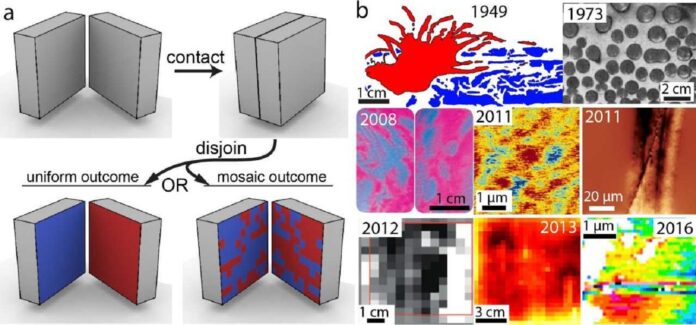Charging of dielectrics on contact and separation has puzzled scientists and engineers for centuries. However, a body of evidence has been mounting that contact electrification can also produce heterogeneous charge distributions in the form of (+/-) charge mosaics on each of the surfaces—yet, despite many attempts, no predictive model explaining the formation of mosaics at different length scales has been proposed; the main line of thinking has been that they must reflect some spatial heterogeneity present in the contacting materials.
Now, scientists at UNIST have determined the possible sources of charge mosaics for over a decade. They found that charge mosaics are a direct consequence of electrostatic discharges (ESD). Through the experiments, they found that the sequences of “sparks” are created between delaminating materials. These materials are responsible for symmetrically forming the (+/-) charge distributions on both materials.
Professor Bartosz A. Grzybowski (Department of Chemistry) from the Center for Soft and Living Matter said, “In our 2011 Science paper [Science 333, 2011, 308–312], we showed sub-micrometer-scale charge non-uniformity of unknown origin. At that time, our hypothesis was to attribute these (+/-) mosaics to the transfer of microscopic material patches between the separated surfaces.”
“However, over many years of work on the problem, this and related models were not holding up, as it was gradually becoming unclear to us (and many other colleagues with whom we discussed) how these microscopic patches can explain even millimeter-scale regions of opposite polarity coexisting on the same surface. Nonetheless, the community and we had no better answer why the (+/-) mosaics are seen at all and over so many length scales.”
Dr. Yaroslav Sobolev, the lead author of the paper, said, “You might think that a discharge can only bring charges to zero, but it can locally invert them. It is connected with the fact that it is much easier to ignite the ‘spark’ than to extinguish it. Even when the charges are reduced to zero, the spark keeps going powered by the field of adjacent regions untouched by this spark.”
The proposed theory clarifies why charge mosaics were observed on various materials, such as paper sheets, rubbing balloons, steel balls moving on Teflon surfaces, or polymers disengaged from the same or other polymers. It also raises the possibility that the popping sound you hear when you pull off a sticky tape results from plasma discharges acting like guitar strings and plucking the tape.
The study that has been presented should assist in reducing electrostatic discharges that could be dangerous and advance our understanding of the nature of contact electrification.
Journal Reference:
- Sobolev, Y.I., Adamkiewicz, W., Siek, M. et al., “Charge mosaics on contact-electrified dielectrics result from polarity-inverting discharges,” Nat. Phys. (2022). DOI: 10.1038/s41567-022-01714-9
